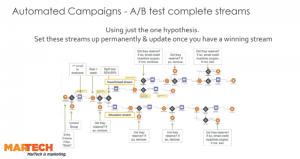— July 31, 2018

Here’s how to get your employees to take ownership!
Tired of employees who don’t take ownership of their work at your agency? This three-part article series is for you!
First, I introduced the Owner vs. Employee mindset gap—and why employees’ instant-gratification decisions can hurt you as the owner. Then, I shared five examples to help you recognize the problem.
Here in Part 3, I’ll share nine ways to fix the problem—specifically, how to get employees to take ownership at your agency.
This doesn’t require giving (or selling) employees equity in the business—it’s about creating systems and behaviors to encourage employees to adopt more of an ownership mindset. Let’s dive in!
9 ways to encourage agency employees to think (and act) like an owner
The exact solution(s) for your agency will depend on the underlying root causes—but these nine tips give you common places to start.
1) Build “think like an owner” into your agency’s values.
Have you defined and shared your agency’s company values? If not, I recommend doing so—agreeing to shared agency values helps everyone stay on the same page, and it’s part of making yourself “needed but not necessary.”
Is there something about ownership in the values? If not, consider finding a way to incorporate it.
You ideally would never need to change your values, but it may be time to do an audit—are your current values accurate? You likely have both descriptive values (what you’re doing now) and aspirational values (what you want to become).
I’ll share more in a future article about how to define your agency’s Mission, Vision, and Values.
2) Define tiered “Swim Lanes” for approving unpaid Scope Creep.
You can use Swim Lanes to clarify employee responsibilities, so they don’t need to ask you (or their manager) every time.
Among other areas, create Swim Lanes around tiers of approvals for unpaid scope creep. For instance, perhaps:
- Front-line employees can automatically approve up to an hour without getting managerial approval.
- Project managers can approve up to five hours.
- Department directors can approve up to 20 hours.
- Executive team members can approve up to 50 hours.
- Anything more than that requires consulting you as the owner.
You’ll need to decide the cutoffs that are right for your agency—but defining and sharing the breakpoints helps employees understand what they should and shouldn’t handle themselves.
Defining Swim Lanes around approvals also makes work easier for your client-facing employees. Instead of feeling put on-the-spot when a client requests a gray-area Out of Scope, they can say, “I’d love to help. I need to speak with my manager to get their approval. I’ll have an answer for you later this week.”
3) Monitor billable hours and total hours each week.
Someone from your operations team should be monitoring timesheets each week, to see how much people are billing and working.
Why weekly? If someone’s underbilling (or undertracking), their PM can call this out promptly, for the employee to address. And if someone’s working far more than expected, the PM can find ways to support them—perhaps adding resources or finding ways to help the employee be more efficient.
Of course, be sure everyone knows their billable and total hours targets—they can’t read your mind.
4) Do regular debriefs after projects and retainers, so everyone can learn from the past.
Are you doing project debriefs (or post-mortems) every time you complete a project or retainer? I recommend it—the debriefs reflect a commitment to continuous improvement.
How does this help you get employees to take ownership? Debriefs include talking about what did and didn’t work—employees are taking responsibility for their actions. If things didn’t go well, they can commit to do things differently next time.
As the owner, you don’t need to lead every project debrief yourself. Ideally, delegate it to your operations team, with the PM leading the debrief. But if you were the salesperson on the deal, you should participate in the debrief. After all, you should take ownership if you undersold or mis-quoted the deal!
5) As a manager, hold people accountable… and be explicit about your concerns.
When someone doesn’t take ownership, call it out—specifically, promptly, and privately. Be an active listener, and give the employee an opportunity to explain their side of the story—perhaps they weren’t aware of something you knew, or maybe they knew something you didn’t.
This means you need to have some difficult conversations—not fun, but part of your job as a manager. The book Crucial Conversations can help.
6) Set expectations about what people should do when they finish early.
Ideally, employees who finish a task early will check their task list for what to do next—or ask a project manager if “what’s next” is unclear. But that may not happen, especially if that’s not your agency’s norm.
I recommend you create an informal hierarchy for how people should prioritize work. For employees focused on client-billable work, it might be something like this:
- Client Billables (work a current client has agreed to pay for)
- Sales Support (contributing to active, urgent sales opportunities)
- Business-Building (building systems to make their work more efficient, doing self-marketing for the agency itself, or otherwise helping the agency improve)
- Professional Development (things to improve their skillset as an employee)
- Administrative Work (contributing to lower-value internal projects)
This prioritization will vary by role and by project lifecycle. For instance:
- People doing self-marketing for the agency should always de-prioritize client work because billables take them away from their primary job.
- Managers should put their managerial role ahead of client billables. That is, their job is to maximize their team’s billable hours, although the manager will likely have some client-billable work, too.
- Everyone should prioritize time-tracking (admin work) at the end of each day, to ensure they’re up to date.
As the owner, you’re ideally focusing primarily on business-building rather than client-billables.
7) Structure your recruiting to hire employees who think (and act) like an Owner.
Hire for conscientiousness. If you hire someone who isn’t conscientious, you’ll likely regret it later. Past work performance tends to predict future results—ask candidates and their references for examples.
Dig into this with candidates directly—use behavioral interview questions. For instance: “Tell me about a time you chose to put your employer before yourself.” (And then ask followup questions to understand their thought process.)
Be a skeptical reference-checker, since candidates are putting their best foot forward. Ask for examples of the employee taking ownership of projects, taking responsibility for mistakes, and stepping up when they didn’t need to.
During a reference check when I was Director of Client Services, a candidate’s former boss talked about how the candidate had made a client-facing mistake… but then fully owned it, including telling the owner and finding a solution. She proved to be an excellent, conscientious hire for my agency.
8) Create incentives for employees to think like an owner.
Most often, this comes in the form of quarterly profit-sharing bonuses. Perhaps you share 20% of quarterly profits with employees—the bonus pool gives them a benefit of thinking like an owner, without your sharing equity itself.
You can go beyond overall profit-sharing to create incentives for special projects. If someone comes up with something that makes you a million dollars, it’s reasonable for them to get a percentage. The key is that they need to complete their baseline job before they go above and beyond.
If you plan to sell your agency and need to retain crucial employees between now and then, consider creating a Phantom Stock plan. Because you can customize the plan, it gives you the employee-retention benefit of equity without the downsides of sharing actual equity.
9) Demonstrate “think like an owner” yourself.
To paraphrase George Washington in Hamilton, your team has its eyes on you. This is, your words and actions as the owner carry far more weight than anyone else at the company. (I’ll share more on that in a future article.)
Are you acting long-term (like an owner) or short-term (like an employee prioritizing personal gain)? For example:
- When traveling on business, do you rent a mid-size car… or an Escalade?
- Do you talk about building long-term client relationships, or are you obviously looking for quick cash?
- Do you fire clients that abuse your team, or do you instead demonstrate that revenue is more important than your team’s happiness?
- Do you hire for competence, or do you practice nepotism and hire incompetent relatives?
- Do you submit mileage reimbursement when you use your personal car for business, or did you lease (or buy!) a flashy company car that the team knows you use primarily for personal trips?
You don’t need to deprive yourself—but remember that your employees are watching, and they’re taking their cues from you.
What about freelancers & vendors?
These tips help with employees—but what about freelancers and other vendors you don’t directly control?
Many of my tips apply to other labor arrangements, too—for instance, setting expectations for a freelancer, creating the right incentives for an ongoing contractor, and monitoring work by an occasional vendor.
In my experience, freelancers tend to have an Ownership mindset already, because they are ultimately running their own business, and you’re their client.
Be sure you provide incentives to help them go above and beyond—like a small monthly discretionary budget for sharing ideas to help your agency. In a future article, I’ll share more about supercharging your freelancer relationships.
Question: How do you create systems and behaviors to get employees to take ownership at your agency?
Business & Finance Articles on Business 2 Community
(65)







